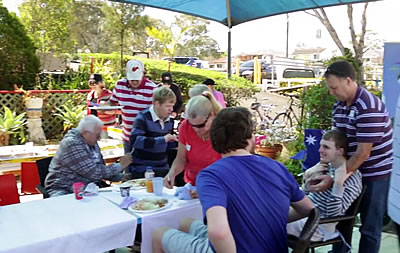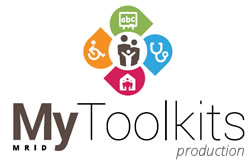 The Angelman Syndrome Association Australia (ASAA) – for families of children with Angelman Syndrome (AS) – and the Kogarah Developmental Assessment Service have been working together since 1993 to support families with this rare syndrome.
The Angelman Syndrome Association Australia (ASAA) – for families of children with Angelman Syndrome (AS) – and the Kogarah Developmental Assessment Service have been working together since 1993 to support families with this rare syndrome.
From the beginning, the priorities of AS families were at the forefront of decision-making processes. As a result of this partnership, a potentially vulnerable group of families have been provided with access to first-class healthcare and support that may not have been otherwise possible. The strength of the relationship twenty years later bears living testimony to the impact and value of co-design. Many original members of the alliance are still involved to this day.
The Angelman Story is a model for how a consumer support group and health service can work together to make a real difference to the lives of those with complex health needs.
And it’s a story well worth telling.
A Rare Syndrome
We haven’t always known about Angelman Syndrome. It is a rare neuro-genetic disorder that was only first described by paediatrician Dr Harry Angelman in 1965. He noted that people with AS tend to have a very happy demeanour and behavioral uniqueness.
Other characteristic features include:
- Intellectual Disability
- Language Impairment
- Sleep Disturbance
- Movement Disorder
- Seizures
In the late 1980s, Dr Angelman’s clinical observations were matched with the discovery of a chromosomal abnormality. It was only then that the syndrome was properly understood and recognition began to develop within the medical community.
A Chance Meeting
Few cases of AS were known in Australia by the early 1990s. Diagnosis required a specialist developmental paediatrician or neurologist to recognise the typical physical and behavioural features.
Prior to 1993, no one at the Kogarah Developmental Assessment Service (DAS) had ever seen a child with AS- but in that year three different families arrived seeking diagnosis and advice.
When the first child was seen, the DAS team suspected AS, but they weren’t completely sure. Dr Robert Leitner worked through the list of features in the clinic’s diagnostic handbook with the young child’s mother, who recognised her daughter in the descriptions immediately. By accident rather than design, she played an active role in establishing the diagnosis of her child’s condition.
Around the same time, two other children in the area were diagnosed and referred to DAS for advice. Clinic appointments were arranged back-to-back, so the families could meet with both Dr Leitner and consulting geneticist Dr Ellie Smith together in the same place.
When the first family emerged from their consultation they found another family, who also had a child with AS, waiting to meet the doctors.
The bond between the families was instantaneous and emotional. These families had known nothing of each other before, but had shared so many of the same experiences.
It was clear to everyone that this chance meeting was the start of an ongoing partnership.
The Catalyst
Awareness of AS was slowly growing around Australia, but it was still a rare and very new condition.
These three AS families in consultation with doctors Leitner and Smith set their minds to organising a gathering for clinicians and families from across the country. Held over a weekend, it would involve both an education and information gathering session, and an opportunity for meeting others and sharing stories.
Fourteen families and a broad range of medical and health specialists took part. Families made rewarding connections and the direct access to clinicians was invaluable. Meanwhile, the gathering also allowed the clinicians to collect detailed data about AS, and a rare opportunity to meet a diverse group of AS children together at the same time. This gathering that was the catalyst for action.
On this weekend, the original AS Association (ASA) was founded ( now renamed the Angelman Syndrome Association Australia ASAA) with the aim of providing a network of support and education, and fostering research. The association became a a pro-active advocate for all families living with AS.
The first priority was to find a health service that understood them, so the Angelman Syndrome Clinic was established at Kogarah DAS by Dr Leitner and Dr Smith. This service has provided multidisciplinary healthcare and support for families with AS, as well as links to other services in government and non-government sectors.
Raising the Profile of Angelman Syndrome
Not long after the association and clinic were formed, 60 Minutes brought the story of Angelman Syndrome to national attention. Within a fortnight sixty new families with children with AS came forward, eager for a diagnosis to be made and to connect with other families.
Both the ASA parent group and the AS Clinic had to figure out how they were going to work together. Firstly, it was decided that everyone who was referred to the AS Clinic would be put in contact with a parent from the ASA and given information including the ASA brochures. Likewise, families who linked first to the parents’ association were put in contact with the clinic.
Together, they were able to offer families social, emotional and medical support.
Creating a Supportive Community
Organisation would be the key to effectiveness. A national association was formed, involving representatives from each state and territory.
Regular communication and get-togethers would encourage AS families to keep in touch, share information and support each other. A mailing list was established and newsletters began. Social events were key – informal, relaxed picnics were organised to bring the families together. Over time the ASA had successfully created an active community and a national support network, so that AS families could feel connected with others who had walked in their shoes and understood their issues.
Partnering with a Health Service
For over twenty years, the ASA, particularly the NSW branch, has been engaged in decision-making processes concerning the ever changing and evolving AS clinic.
Originally the clinic’s main function was around diagnosis and coordination of specialist services, such as genetic counselling, orthopaedics, sleep, neurology, allergy and nutrition.
Over time, as genetic testing became more readily available, and the range of ages within the AS community has broadened, there is a shift towards issues around aging and mobility, and a stronger focus on transition to adult services. Connections have been made with a wider range of specialties, including psychiatry and rehabilitation. Access to allied health and nursing support is also offered, including occupational therapy, physiotherapy, psychology and social work.
The AS Clinic has had to adapt with changing times and now also provides medical advice and support via phone calls and email, in addition to its individual face-to-face clinics.
Initially, data collection and analysis aimed to establish a clear picture of the natural history and behaviour of people with AS in Australia. Now, more emphasis is being placed on longitudinal studies to explore what happens as people with AS grow into adulthood.
Making the Partnership Work
While the ASA and the AS Clinic operate independently from each other, their functions are often integrated. Their primary goals are the same – to ensure that those living with AS enjoy the best possible health and quality of life.
- If a social gathering is organised for AS families, the AS Clinic doctors and health professionals are invited to come along too.
- The ASA newsletter sometimes contains a ‘Clinic Chat’ update (about research or services) from one of the clinicians.
- The AS Clinic assists with educational forums when information becomes available that will be of interest to AS families.
- When the clinicians consider collecting a new set of data, they turn first to the ASA and AS families for their input.
- A number of tools have helped the ASA and AS Clinic to work together. These have included focus groups and forums, questionnaires and surveys, seminars and social gatherings.
- Feedback and review structures were built into the AS Clinic from the outset and continue to shape everything from daily practices to research.
- Going one step further, the Kogarah DAS and AS Clinic have employed a social worker who is a parent with an AS child with lived experience of disability to act specifically as a carer’s advocate within the service.
The ASA and AS Clinic partnership is also illustrated in the conferences they organise together, ensuring a balance of educational and informal networking events. The ASA bring everyone together, and the AS Clinic assists with provision of resources, professional and clinical speakers, venues, and encourages families from rural or remote areas to attend by assisting to keep costs down.
Families and clinicians participate side-by-side in conference activities, by mutual learning they seek to better understand AS children and adults to further improve their quality of life.
This model of collaboration is responsible for developing the constantly evolving AS Clinic, and assists with redesign of clinical processes. It has driven research and to make a difference.
The Partnership Evolves
The partnership between the ASA and the AS Clinic continues to evolve.
New technology is used wherever possible – the ASA website, has been updated and a facebook page developed.The AS Clinic is exploring the use of teleconferencing and videoconferencing for client consultations.
The AS Clinic offers outreach services and advice for remotely located AS families through the designated AS Clinic email which has been established to answer enquiries from families and professionals wherever they may be – local, regional, interstate or even overseas.
Furthermore, the AS Clinic offers education and training for medical and allied health staff and education staff which aims to increase awareness of the condition in the mainstream health community.
The vision is striving for better health and quality of life for people with AS and their families into the future.





